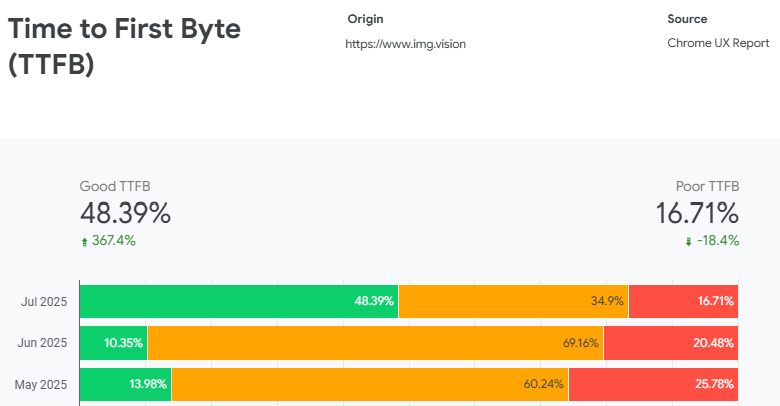At Img.vision we care deeply about performance. Our customers rely on us for fast and reliable image and video delivery on marketplaces like eBay, Amazon, and Walmart. That means speed isn’t just a nice-to-have, it’s part of our product promise.
Recently, we made some major infrastructure improvements by upgrading our CDN to Enterprise level, and the results speak for themselves.
Why real-world speed matters
When most people test their website performance, they use tools like Lighthouse or GTmetrix. These are lab tests: they simulate a page load on a single device, from a single location, under controlled conditions.
But Google ranks sites based on real-world user data, collected through the Chrome User Experience Report (CrUX). This dataset is built from anonymized Chrome browser visits worldwide and powers both PageSpeed Insights and Core Web Vitals.
For SEO professionals, this is critical:
- CrUX data influences how Google measures site performance.
- Faster speeds → better user experience → better rankings.
A key metric: Time to First Byte (TTFB)
One of the most important numbers in CrUX is Time to First Byte (TTFB). It measures how long it takes for a browser to receive the first response from your server.
Why TTFB matters:
- A faster TTFB reduces the total time it takes for a page to load.
- Google factors it into Core Web Vitals scoring.
- It also affects crawl efficiency: the faster Googlebot can fetch your pages, the more of your site it can crawl.
What we changed
In July, we upgraded Img.vision to Enterprise level at our infrastrcture provider and rolled out several key optimizations:
1. HTML Caching
Instead of generating our marketing pages dynamically for every visitor, we now cache entire HTML pages at the edge. That means when a user visits img.vision, the page is delivered instantly from the nearest CDN location.
👉 Benefit: Faster marketing site, better landing page experience, and stronger SEO performance.
2. Argo Smart Routing
Internet traffic doesn’t always take the fastest path. Argo Smart Routing uses network intelligence to route traffic across the least congested and fastest routes.
👉 Benefit: Lower latency for global users of our app and CDN.
3. Tiered & Regional PoP Caching
Instead of every request going all the way back to our origin servers, content is pulled from regional caches closer to the user.
👉 Benefit: Consistently low response times for both app users and image delivery worldwide.
The results
The impact was immediate in our CrUX dataset:
- Good TTFB increased from 13% → 48% (+269%)
- Poor TTFB dropped from 25% → 16% (–36%)
These are real-user numbers, measured by Chrome, and the exact same numbers Google uses in its ranking system.
Why this matters for our customers
For Img.vision users, this means:
- Faster marketing site → quicker signups and better first impressions.
- Faster app performance → smoother uploads and management of your media.
- Faster image delivery → better conversions on marketplaces like eBay, Amazon, and Walmart.
Speed is not just a technical metric, it’s directly tied to SEO visibility, user trust, and ultimately, sales.
Final thoughts
Infrastructure is often invisible until it slows you down. By investing in an infrastructure Enterprise plan, we’ve ensured Img.vision is not only fast but fast where it counts, in Google’s eyes and in your customers’ browsers.
💡 If you run your own website, check your CrUX metrics. They might reveal opportunities for SEO improvements you can’t see in lab tools.
At Img.vision, we’ll continue to optimize performance so your images and videos load instantly, helping you stand out in competitive marketplaces.

